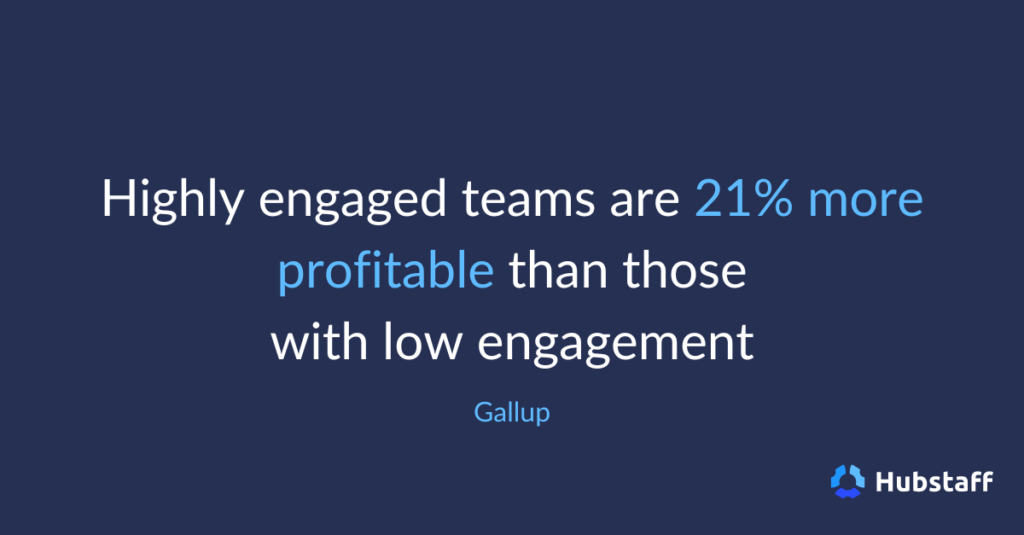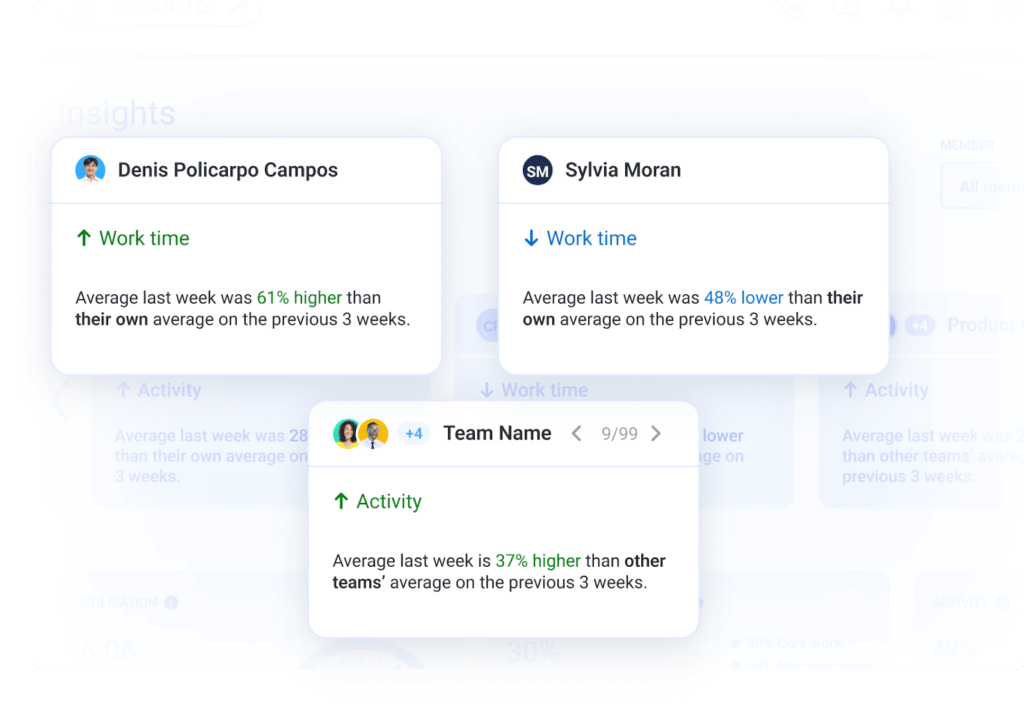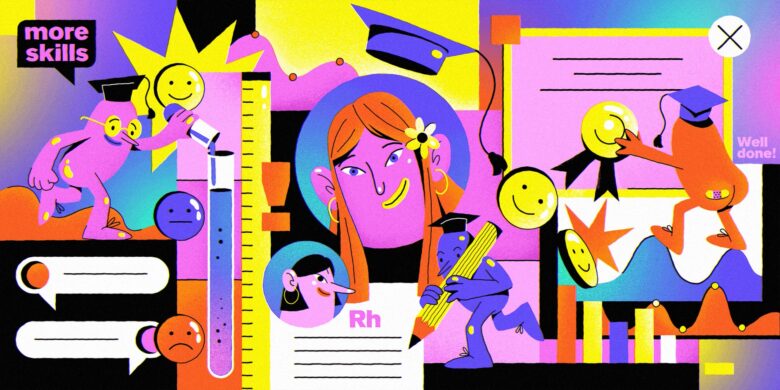Identifying a high performer in your organization isn’t always about who stays late or talks the loudest in meetings. It’s about recognizing those who quietly drive success, demonstrating an exceptional blend of skill, dedication, and strategic thinking.
Spotting high performers is vital — you’re not just keeping your key employees motivated. You’re also setting the stage for your whole team to thrive and find innovative solutions.
How can you find your top performers? To find your top performers, keep an eye on who consistently raises the bar, pioneers new solutions, and turns challenges into opportunities for team success.
This article offers a clear guide for recognizing these pivotal individuals, outlining the critical high-performer characteristics and behaviors that distinguish them from their peers. We’ll explore how to spot and cultivate the high performers crucial to your organization’s success.
Boost your team’s efficiency with Hubstaff's productivity tools
What are high performers?

High performers are individuals within an organization who consistently exceed expectations and deliver exceptional results in their roles. They are the powerhouses driving your company forward with extraordinary skills, dedication, and transformative thinking.
Statistically speaking, only a tiny percentage (around 2% to 5%) are your highest-performing employees, so weeding them from the larger group can be intimidating.
Let’s paint a picture of these high performers so you know what to look for and how to identify and recruit high performers.
What does a high performer look like?
- They routinely surpass expectations, hitting all key performance indicators (KPIs).
- They actively seek new challenges and are always ahead in finding solutions.
- They quickly adjust to changes and thrive in dynamic environments.
- They excel in delivering clear and persuasive communication.
- They enhance team morale to improve productivity.
Understanding the traits of high performers helps us appreciate what they bring to their roles and the broader benefits they offer to the entire organization.
Now, let’s explore the significant advantages that high performers contribute to their teams (and the company as a whole) and why investing in these individuals can have a transformative impact.
What can a high-performance person bring to an organization?
High-performance individuals can bring countless benefits to a company, enhancing its operations and culture. While it seems obvious that a high-performing employee improves your culture, it’s essential to drive home the impact because it goes beyond one employee hitting their goals.
Research has found that the top 1% of employees produce 10% of the output, while the top 5% produces 26% of the total output.
This staggering statistic demonstrates what is at stake here, but let’s look at some of the more soft-skill-related contributions.
Critical contributions top performers make
- Higher employee engagement. By setting a high-performance standard, they often raise the bar for everyone, which then leads to increased engagement across the workforce. This increased productivity and engagement can have a positive impact on your profits. According to Gallup, highly productive and engaged teams are more profitable.

- Enhanced innovation. High-performing teams are more likely to implement innovations successfully. Brainstorming sessions and ideations are more efficient and effective whenever high-performing employees are in the room.
- Leadership development. High performers often possess natural leadership qualities that can be further developed, helping to nurture a strong leadership pipeline within the organization. Plus, they know how to encourage others and are strong mentors for those working under them.
- Attracting talent. Organizations known for employing high performers attract other talented individuals, which then enhances the overall quality of the workforce. Talent optimization can’t be overlooked, as talent-optimized teams are more likely to meet their goals.

- Increased retention. In an era of quiet quitting, retaining talent and reducing turnover is vital. Research shows that high-performing, engaged employees are 87% less likely to leave their company.
High performers do more than just meet their targets. They also uplift the entire organization, enhancing team spirit, sparking innovation, and attracting top talent. Their impact on improving profits and employee retention can’t be overstated.
Now, let’s focus on the traits that set these top employees apart.
Traits common to top employees
Top employees often share distinct qualities that set them apart and make them highly valuable to any organization. Recognizing and investing in employees who exhibit these traits can enhance a company’s productivity and culture.
These are the common qualities of top employees:
A quality-first mindset
Employees who prioritize quality are dedicated to maintaining high standards in all aspects of their work. High performers tend to pay close attention to detail and consistently deliver work that meets or exceeds expectations.
How managers can support this behavior: Invest in these employees by providing them with opportunities to lead quality assurance projects or develop company-wide best practices, enhancing the overall output quality.
Seeking out skill development
High performers have a growth mindset and seek skill development to consistently achieve their goals. This trait helps them continually pursue personal and professional growth through learning and applying new skills.
How managers can support this behavior: Supporting employees with access to training programs, workshops, and continued education can lead to innovations and improvements in processes and services. This can then keep the company competitive from a retention and recruitment standpoint.

Strategic thinking
Strategic thinkers can see the bigger picture, plan long-term strategies, and anticipate potential challenges and opportunities.
How managers can support this behavior: Leaders can leverage this skill by involving these employees in strategic planning sessions and decision-making processes. This then helps better align tactical initiatives with long-term business goals.
Taking initiative
Most performers can follow orders, but high performers can often anticipate what the company needs. When one takes initiative, it involves taking proactive steps to improve processes, solve problems, or implement new ideas without being asked.
How managers can support this behavior: Encouraging and rewarding those who take initiative can foster innovation and active engagement. Managers can then give such employees lead roles in projects or pilot programs to capitalize on their proactive nature.
Investing in employees who exhibit these traits boosts their performance and contributes significantly to the organizational culture and success. These employees often become the driving force behind continuous improvement and competitive advantage in the marketplace.
Differences between high performers and high-potential individuals
High performers and high-potential individuals are valuable assets to any organization, but they differ significantly in their impact and roles within the company. High performers aren’t always high-potential employees, and vice versa.

Source: SaaSworthy
Understanding the difference between a high potential vs. high performer is crucial for effective talent management.
Here’s a breakdown of the key distinctions:
High performers
Impact: High performers excel in their current roles, consistently exceeding expectations and delivering excellent results.
Skills and competencies: They possess the necessary skills and expertise to excel in their job functions.
Focus: Their contributions are often measurable and focus on delivering top results in their current tasks and responsibilities.
Role in the organization: High performers are the organization’s engine in their current roles, crucial for maintaining high operational efficiency and success.
High-potential individuals
Impact: High-potential individuals can assume more extensive, often leadership, roles within the organization in the future.
Skills and competencies: They show a broader range of skills that apply to their current role and extend to higher, more strategic positions. This includes strong leadership qualities, adaptability, and strategic thinking.
Focus: While they perform well in their current roles, the defining feature is their potential for significant growth and ability to succeed in more prominent roles beyond their current scope.
Role in the organization: High-potential individuals are future leaders or critical contributors who will drive the organization’s growth and adapt to changing business landscapes. They are typically nurtured through leadership development programs, succession planning, and rotational assignments to prepare them for future challenges.
High performer vs. high potential employee: What’s the difference?
While high performers are indispensable for their mastery and exceptional contribution to current objectives, high-potential individuals are groomed for advancement and expected to deliver significant impact in broader roles.
Just because an employee shows promise doesn’t mean they’ll inevitably reach their full potential. Current leaders (and also the employees themselves) to nurture these skills.
Effective management involves recognizing the difference between the two and strategically developing and engaging each type to leverage their unique strengths for organizational success.
Use software to identify and retain top performers

Hubstaff is an all-in-one workforce management tool that can help managers identify high performers using detailed reports and productivity insights. Hubstaff is designed with your productivity in mind, and it can help managers find their top performers automatically.
Here are the key features businesses love:
- Using employee time tracking, managers can see who is working on what and how long each task takes. Hours worked convert to automated, real-time timesheets that simplify payroll.
- For productivity metrics, you can use features like optional screenshots, app and URL usage, and activity scores to help leaders check in with remote employees and prevent burnout.
- With the Insights add-on, managers can gain additional workforce insights like time spent in meetings, set work time targets to prevent overworking, detect unusual activity, and compare productivity metrics with industry-specific benchmarks.
Managers streamline operations by leveraging tools like Hubstaff to measure and enhance workforce productivity and pinpoint the high performers who drive success. More importantly, managers can ensure that high performers are engaged and prevent overworking.
Recognizing and cultivating these individuals is about acknowledging their current contributions and strategically empowering them to shape your organization’s future. This focus on nurturing high performers ensures your company remains dynamic, innovative, and ahead of the curve in even the most competitive business environments.
Most popular
The Fundamentals of Employee Goal Setting
Employee goal setting is crucial for reaching broader business goals, but a lot of us struggle to know where to start. American...
Data-Driven Productivity with Hubstaff Insights: Webinar Recap
In our recent webinar, the product team provided a deep overview of the Hubstaff Insights add-on, a powerful productivity measurem...
The Critical Role of Employee Monitoring and Workplace Security
Why do we need employee monitoring and workplace security? Companies had to adapt fast when the world shifted to remote work...
15 Ways to Use AI in the Workforce
Whether through AI-powered project management, strategic planning, or simply automating simple admin work, we’ve seen a dramatic...




